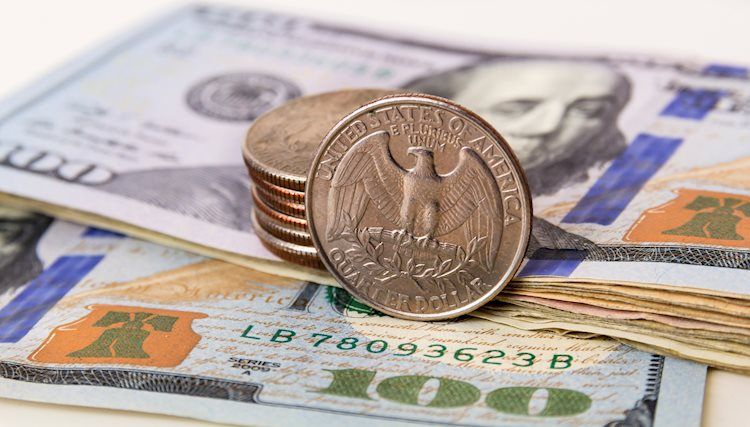The US dollar recorded another down session, weakened by the Federal Reserve’s dovish stance.

- The DXY index hovered around 101.90, its lowest since August.
- Despite positive retail sales figures in November, the US dollar continues to weaken.
- The US dollar is suffering in the aftermath of the Federal Reserve’s announcement on Wednesday.
- U.S. 2-year Treasury yield falls to lowest since June.
The US dollar (USD) fell to 101.80, its weakest since August. Unexpected hints that the Federal Reserve may cut interest rates three times in 2024 are weighing heavily on U.S. Treasury yields and the U.S. dollar.
At the Fed’s last meeting of 2023, the bank welcomed cooling inflation numbers and a revised dot plot suggests the Fed president will not see interest rates rise in 2024. They also predicted an easing of 75 basis points. This means that market expectations are aligned with the bank’s position, which is welcomed by the market as it stimulates flow towards risk.
Daily market movers: US dollar falls despite positive retail sales figures, US yields hit multi-month lows
- The Federal Reserve has hinted at three rate cuts in 2024, putting pressure on the U.S. dollar.
- The November retail sales report released by the U.S. Census Bureau showed a 4.1% increase compared to the same period last year, which was stronger than the 2.2% increase the previous month.
- The U.S. Department of Labor reported 202K new jobless claims for the week ended December 9, below the consensus of 220K and the previous figure of 221K, signaling an unexpectedly healthy job market.
- Currently, US bond yields are falling to 4.35% for 2-year bonds, 3.87% for 5-year bonds, and 3.91% for 10-year bonds.
- Markets expect a rate cut as early as March 2024, according to CME FedWatch Tool forecasts.
Technical Analysis: DXY Index bears lead the way, with the indicator jumping into negative territory.
The Moving Average Convergence Divergence (MACD) histogram shows a rising red bar. This is usually a signal associated with bearish momentum, and the Relative Strength Index (RSI) is nearing oversold conditions, further confirming that bears dominate the price movement.
Moreover, looking at the simple moving average (SMA), the index is positioned below the 20-day, 100-day, and 200-day SMA, indicating a dominant bearish bias in the larger context. This suggests that despite the oversold RSI suggesting temporary relief, overall selling pressure remains strong and weakness continues to dominate price action.
Support levels: 101.50, 101.30, 101.00.
Resistance levels: 103.45 (bearish crossover of 20-day and 200-day SMA), 104.50 (100-day SMA), 104.70.
Risk Appraisal FAQs
“Risk-on” and “risk off,” two terms widely used in the world of financial jargon, refer to the level of risk an investor is willing to take over a given period of time. In “risky” markets, investors are optimistic about the future and are more willing to purchase risky assets. In “risk-averse” markets, investors start to play it ‘play it safe’ because they are worried about the future. Therefore, we buy less risky assets that are more certain to bring us returns, even if they are relatively small.
Typically, during “risk” periods, stock markets rise and most commodities except gold also rise in value because they benefit from positive growth prospects. Rising demand strengthens the currency of countries that export heavy industry and pushes cryptocurrencies higher. In a “risk-averse” market, bonds rise, especially major government bonds. Gold shines and safe-haven currencies such as the Japanese Yen, Swiss Franc and US Dollar all benefit.
Minor FX such as the Australian Dollar (AUD), Canadian Dollar (CAD), New Zealand Dollar (NZD), Ruble (RUB) and South African Rand (ZAR) all tend to rise in “risk-on” markets. “. This is because the economies of these currencies rely heavily on raw material exports for growth, and raw material prices tend to rise during risk periods. This is because investors expect higher demand for raw materials in the future due to increased economic activity. no see.
Major currencies that tend to rise during “hedging” periods are the US dollar (USD), Japanese yen (JPY), and Swiss franc (CHF). The U.S. dollar is the world’s reserve currency and is considered safe because investors buy U.S. government debt in times of crisis, making it unlikely that the world’s largest economy will default on its debt. The yen weakened due to increased demand for Japanese government bonds. This is because domestic investors, who are unlikely to sell it even in a crisis, hold a high proportion of it. The Swiss franc is traded because strict Swiss banking laws provide investors with enhanced capital protection.
Source: https://www.fxstreet.com/news/us-dollar-plunges-to-multi-month-lows-amid-dovish-fed-202312141808



